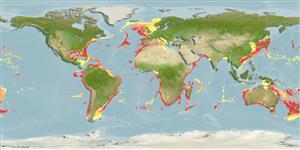Elasmobranchii (sharks and rays) >
Squaliformes (Bramble, sleeper and dogfish sharks) >
Dalatiidae (Sleeper sharks)
Etymology: Dalatias: Greek, dalos, ou = torch, burning piece of wood (Ref. 45335).
Environment / Climate / Range
Ecology
Marine; bathydemersal; depth range 37 - 1800 m (Ref. 247), usually 300 - 600 m (Ref. 247). Deep-water, preferred 22°C (Ref. 107945); 72°N - 56°S, 98°W - 153°W
Western Atlantic: Georges Bank and northern Gulf of Mexico. Eastern Atlantic: Iceland (Ref. 12462), Scotland, and Irish Atlantic slope to Morocco, western Mediterranean, Madeira to Cameroon. Western Indian Ocean: Mozambique and South Africa. Western Pacific: Japan, Australia, and New Zealand. Central Pacific: Hawaii.
Length at first maturity / Size / Weight / Age
Maturity: Lm ?, range 117 - 159 cm
Max length : 182 cm TL male/unsexed; (Ref. 10717)
Dorsal
spines
(total): 0;
Dorsal
soft rays
(total): 0;
Anal
spines: 0;
Anal
soft rays: 0. Moderately sized, short- and blunt-snouted shark with two almost equal-sized dorsal fins; papillose thick lips; small slender-cusped upper teeth and very large lower teeth with erect triangular serrated cusps and distal blades; first dorsal fin on back with its origin behind the pectoral rear tips and its base closer to the pectoral base than the pelvic fins; and caudal fin with the ventral lobe not expanded (Ref. 247). Dark grey-brown to black; trailing edges of fins translucent (Ref. 26346).
Found on outer continental and insular shelves and slopes (Ref. 247). Mainly found on or near the bottom but readily occurs well off the substrate (Ref. 247, 58302). Often pelagic (Ref. 58302). Found singly or in small schools (Ref. 6871). Feeds mainly on deepwater bony fish, but also skates, other sharks, cephalopods and crustaceans (Ref. 5578). Ovoviviparous (Ref. 205), with 10-20 young born at 30-42 cm (Ref. 26346). Used for its squalene liver oil, leather and meat, as well as for fishmeal (Ref. 6871).
Ovoviviparous (Ref. 247). 10-20 young born at 30-42 cm (Ref. 26346); 10-16 young born at 30 cm TL (Ref.58048). Distinct pairing with embrace (Ref. 205).
Compagno, L.J.V., 1984. FAO Species Catalogue. Vol. 4. Sharks of the world. An annotated and illustrated catalogue of shark species known to date. Part 1 - Hexanchiformes to Lamniformes. FAO Fish. Synop. 125(4/1):1-249. Rome, FAO. (Ref. 247)
IUCN Red List Status (Ref. 115185)
CITES (Ref. 94142)
Not Evaluated
Threat to humans
Harmless
Human uses
Fisheries: minor commercial
More information
ReferencesAquacultureAquaculture profileStrainsGeneticsAllele frequenciesHeritabilityDiseasesProcessingMass conversion
Tools
Special reports
Download XML
Internet sources
